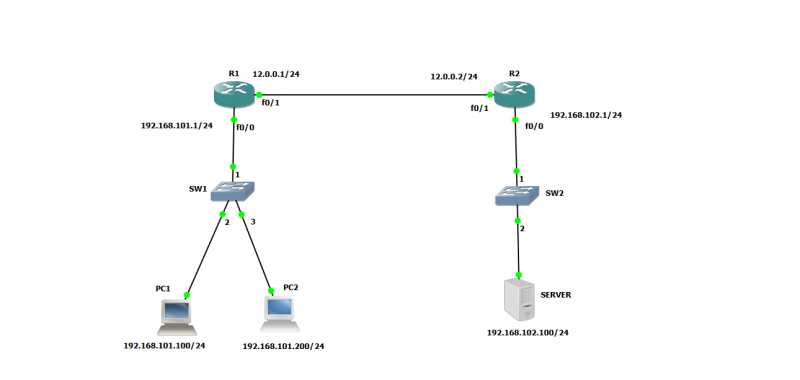How to configure Default Routing on Cisco Routers?

Network Administrator
Here's a video tutorial made by Network Bulls students on How to Configure Default Routing:
This video tutorial is a Step by Step Configuration guide for Default Routing on Cisco Routers.
DEFAULT-ROUTING

We have configured 2 cisco routers R1 and R2 with statically assigned default route to reach to the network they don’t know
Configuration on cisco router for Default-Routing is as following:
Router(config)#ip route 0.0.0.0 0.0.0.0 (next-hop ip address/exit interface-Id) Administrative Distance
Default-route has default Administrative Distance value as 1.
So according to topology we have configure R1 and R2 with default route as following:
R1(config)#ip route 0.0.0.0 0.0.0.0 12.0.0.2
Leaving Administrative Distance value as default value
To check this route on router command is following:
R1#sh ip route
Codes: C - connected, S - static, R - RIP, M - mobile, B - BGP
D - EIGRP, EX - EIGRP external, O - OSPF, IA - OSPF inter area
N1 - OSPF NSSA external type 1, N2 - OSPF NSSA external type 2
E1 - OSPF external type 1, E2 - OSPF external type 2
i - IS-IS, su - IS-IS summary, L1 - IS-IS level-1, L2 - IS-IS level-2
ia - IS-IS inter area, * - candidate default, U - per-user static route
o - ODR, P - periodic downloaded static route
Gateway of last resort is 12.0.0.2 to network 0.0.0.0
12.0.0.0/24 is subnetted, 1 subnets
C 12.0.0.0 is directly connected, FastEthernet0/1
C 192.168.101.0/24 is directly connected, FastEthernet0/0
S* 0.0.0.0/0 [1/0] via 12.0.0.2
On Router R2 default-route configuration is as following:
R2(config)#ip route 0.0.0.0 0.0.0.0 12.0.0.1
Leaving Administrative distance value as default value
To check this route on router command is following:
R2#sh ip route
Codes: C - connected, S - static, R - RIP, M - mobile, B - BGP
D - EIGRP, EX - EIGRP external, O - OSPF, IA - OSPF inter area
N1 - OSPF NSSA external type 1, N2 - OSPF NSSA external type 2
E1 - OSPF external type 1, E2 - OSPF external type 2
i - IS-IS, su - IS-IS summary, L1 - IS-IS level-1, L2 - IS-IS level-2
ia - IS-IS inter area, * - candidate default, U - per-user static route
o - ODR, P - periodic downloaded static route
Gateway of last resort is 12.0.0.1 to network 0.0.0.0
12.0.0.0/24 is subnetted, 1 subnets
C 12.0.0.0 is directly connected, FastEthernet0/1
C 192.168.102.0/24 is directly connected, FastEthernet0/0
S* 0.0.0.0/0 [1/0] via 12.0.0.1
Which default route you want to configure?
Static default or Dynamicly?
Perform these steps to configure a default route.
- Enter global configuration mode. device# configure terminal.
- Enter 0.0. 0.0 0.0.
- (Optional) Enable the default network route for static route next-hop resolution
- (Optional) Configure next-hop recursive lookup to resolve the next-hop gateway
Regards :
ccie classes in Mumbai
ccie classes in Delhi
ccie classes in chennai
ccie classes in banglore
ccie classes in indore
ccie classes in Ahmedabad
ccie classes in kolkata
ccie classes in noida
- How can you guarantee a job for students who has no experience in Networking field?
- How to configure VPN between Cisco Router and ASA Firewall?
- How to configure RIPV2 with no auto summary?
- How to configure PAT (Port Address Translation)?
- How to configure Default Routing on Cisco Routers?
- What is the scope of CCNA course in India?
- What is scope of CCIE?
- How to remember 7 layers of OSI Model?
- How much salary can we get after doing CCNA course in Delhi Gurgaon?
- How many CCIE’s are there worldwide?
- Is it possible to pass CCIE Certification in 1st attempt?








